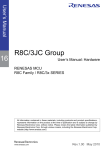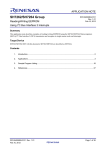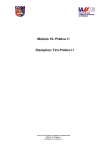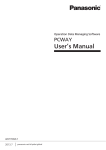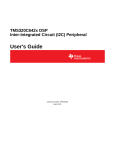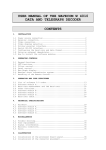Download I2C bus interface (RIIC)
Transcript
Date: Jan. 15, 2013 RENESAS TECHNICAL UPDATE 1753, Shimonumabe, Nakahara-ku, Kawasaki-shi, Kanagawa 211-8668 Japan Renesas Electronics Corporation Product Category MPU/MCU 2 I C bus interface (RIIC) Precautions for using timeout detection function and stop condition issuance timing when receiving master. Title Document No. TN-RX*-A048A/E Information Category Technical Notification Rev. 1.00 Lot No. Applicable Product RX630 group RX63N, RX631 group All lots Reference Document RX630 group RX63N, RX631 group User’s Manual, Hardware section This is to let you know that we have revised the Technical Update which had been already issued (Issue number: TN-RX*-A012A/E Rev.1.00, TN-RX*-A013A/E Rev.1.00). The revised portions are indicated in red letters (in flow chart, indicated in red and blue letters). 1. Precautions for stop condition issuance timing when receiving master 2 With I C bus interface (RIIC), one clock cycle may be inserted between the ninth clock cycle of master reception and stop condition issuance. When this clock affects the communication, follow the avoidance flow “Figure xx.10 Example of Master Reception Flowchart (7-Bit Address Format)” indicated on the Page.6 of this Technical Update. (1) Conditions ・While holding at low at the falling edge of the ninth clock cycle, writing SP=1 and reading data from ICDRR are performed in a row. ・When data is read from ICDRR after the falling edge of the ninth clock of master reception and writing SP=1 are detected at the same time in the RIIC. ・After SP=1 is written, when the falling edge of the ninth clock cycle of master reception and data reading from ICDRR are detected at the same time in the RIIC. (2) Phenomenon One clock cycle is inserted between the ninth clock cycle of master reception and stop condition issuance. 2. Precautions when using timeout detection function 2 While timeout detection function of I C bus interface (RIIC) is set to CMR1.CKS [2:0] ≠ 000b, timeout is detected even when communications are proceeding correctly. To avoid this, use registered disclosed in this document and follow the avoidance flow. In this avoidance flow, every time data is accessed, write 00h to the timeout internal counter and clear counter. Thus, it is applicable only to data transfer using CPU or one using DTC. When you use DMAC for data transfer of RIIC, you need to set ICMR1.CKS [2:0] = 000b or change it to transfer using CPU or one using DTC. (c) 2013. Renesas Electronics Corporation. All rights reserved. Page 1 of 10 RENESAS TECHNICAL UPDATE TN-RX*-A048A/E Date: January 15, 2013 (1) Condition 2 When using timeout detection function of I C bus interface (RIIC) under the setting of CMR1.CKS [2:0] ≠ 000. (2) Phenomenon Even when communications are proceeding correctly, timeout is detected from a set of ICFER.TMOE bit after a certain period of time for detection has elapsed. (3) Disclosed register ① ICMR2.TMWE bit (b3) of I2C bus mode register (ICMR2) will be disclosed. b7 b5 b6 DLCS Bit b3 SDDL[2:0] 0 リセット後の値 Symbol TMWE b4 0 0 0 b3 b2 b1 b0 TMWE TMOH TMOL TMOS 0 0 0 0 Bit name Description R/W Timeout internal counter write enable bit 0: Writing to internal counter of timeout detection function is disabled R/W 1: Writing to internal counter of timeout detection function is enabled When this bit is set to “1”, the address of timeout internal counter (TMOCNTL/U) is allocated to the address of SARL0/SARU0. ② Disclose the timeout internal counter register (TMOCNT). Timeout internal counter (TMOCNT) Address RIIC0.TMOCNTL 0008 830Ah*, RIIC0.TMOCNTU 0008 832Ah* RIIC1.TMOCNTL 0008 830Bh*, RIIC1.TMOCNTU 0008 832Bh* *Same addresses with ones of the slave address registers, SARL0, SARU0. Care should be taken. ・TMOS=0 (Long mode) Value after reset b7 b6 b5 b4 b3 b2 b1 b0 b7 b6 b5 b4 b3 b2 b1 b0 0 0 0 0 0 0 0 0 0 0 0 0 0 0 0 0 TMOCNTU TMOCNTL ・TMOS=1 (Short mode) Value after reset b7 b6 b5 b4 ー ー ー ー 0 0 0 0 b3 b2 b1 b0 b7 b6 b5 b4 b3 b2 b1 b0 0 0 0 0 0 0 0 0 0 0 0 0 TMOCNTU TMOCNTL Page 2 of 10 RENESAS TECHNICAL UPDATE TN-RX*-A048A/E Date: January 15, 2013 Bit Symbol Bit name Description R/W b7-0 TMOCNTL Timeout internal counter Timeout internal counter low-order W *1 *1 : Value in timeout internal counter cannot be read. When value is read, the read value is FFh. Bit b7-0 Symbol TMOCNTU Bit name Description Timeout internal counter R/W Timeout internal counter high-order *1 W *2 *1 : With TMOS=1 (Short mode), b7-b4 are reserved bits. They are writable, however value written is disabled. *2 : Value in timeout internal counter cannot be read. When value is read, the read value is FFh. Timeout internal counter ( TMOCNTL/TMOCNTU ) is initialized (00h) after a reset, while ICCR1.IICRST=1 or ICFER.TMOE=1 and PCLK/1 is selected with ICMR1.CKS[2:0]=000b setting, and when counter clear conditions specified by TMOH/TMOL of ICMR2 (SCL rising edge/falling edge detection) are satisfied. TMOCNTL register and TMOCNTU register comprise a single 16-bit register so they can be accessed together by 16-bit transfer instruction. In case of 16-bit access, please access to the address indicated in the table “Register Allocation for 16-Bit Access” below. Table. Register Allocation for 16-Bit Access Address Upper 8 Bits Lower 8 Bits 0008 830Ah RIIC0.TMOCNTU RIIC0.TMOCNTL 0008 832Ah RIIC1.TMOCNTU RIIC1.TMOCNTL Page 3 of 10 RENESAS TECHNICAL UPDATE TN-RX*-A048A/E 3. Date: January 15, 2013 Avoidance Flow To avoid “1. Precautions for stop condition issuance timing when receiving master” and “2. Precautions for timeout detection function”, add the procedures to the flowchart in the user’s manual. Additional procedures for “1. Precautions for stop condition issuance timing when receiving master” are marked in blue, and those for “2. Precautions for using timeout detection function” are marked in red. 2 “xx” as in Figure xx.5 indicates the chapter of I C of the user’s manual respectively. Please refer to the “Target products and Reference” for details. Initial settings SCL and SDA pins in inactive state ICCR1.ICE=0 RIIC reset ICCR1.IICRST=1 Internal reset ICCR1.ICE=1 Set SARLy and SARUy, Set ICSER Set slave address format and slave address Set ICMR1.CKS[2:0] Set ICBRL/ICBRH Set transfer bit rate Set ICMR2 and ICMR3 (*2) ICMR2.TMWE=1 (*2) TMOCNTL=00h (*2,4) TMOCNTU=00h ICFER.TMOE=1 (*2) Set ICFER (*2) (*1) Timeout internal counter writing enable (*3) Initialization of timeout internal counter (*3) Timeout function enable Set ICIER Set interrupt enable ICCR1.IICRST=0 Cancel internal reset End (*3) y=0~2 *1. When the RIIC is used only in slave mode, set the ICBRL register to a value longer than the data setup time. *2. Set these registers as necessary. *3. These steps need to be included if the timeout function is to be used. They are not required if the timeout function is not to be used. *4. Flowchart shows 8-bit access case. In case of 16-bit access, write 0000h to the address indicated in the table “Register Allocation for 16-Bit Access”. Figure xx.5 Example of RIIC Initialization Flow Page 4 of 10 RENESAS TECHNICAL UPDATE TN-RX*-A048A/E Date: January 15, 2013 Master transmission [1] Initial settings Initial settings No ICCR2.BBSY=0? [2] Check I2C bus occupation and issue a start condition. Yes ICCR2.ST=1 ICSR2.NACKF=0? No Yes No ICSR2.TDRE=1? Yes TMOCNTL=00h TMOCNTU=00h [3] Transmit slave address and W (first byte) [4] Check ACK and set transmit data. (*1,2) Write data to ICDRT No All data transmitted? Yes No ICSR2.TEND=1? Yes TMOCNTL=00h TMOCNTU=00h [5] Check end of last data transmission and issue a stop condition. (*1,2) ICSR2.STOP=0 ICCR2.SP=1 No [6] Check stop condition issuance. ICSR2.STOP=1? Yes TMOCNTL=00h TMOCNTU=00h (*1,2) [7] Processing for the next transfer operation. ICSR2.NACKF=0 ICSR2.STOP=0 End of master transmission *1. These steps need to be included if the timeout function is to be used. They are not required if the timeout function is not to be used. *2. Flowchart shows 8-bit access case. In case of 16-bit access, write 0000h to the address indicated in the table “Register Allocation for 16Bit Access”. Figure xx.6 Example of Master Transmission Flowchart Page 5 of 10 RENESAS TECHNICAL UPDATE TN-RX*-A048A/E Date: January 15, 2013 Master reception [1] Initial settings Initial settings No ICCR2.BBSY=0? [2] Check I2C bus occupation and issue a start condition. Yes ICCR2.ST=1 No ICSR2.TDRE=1? Yes TMOCNTL=00h (*1,2) TMOCNTU=00h Write data to ICDRT No [3] Transmit slave address and R, and check ACK. ICSR2.RDRF=1? Yes TMOCNTL=00h (*1,2) TMOCNTU=00h ICSR2.NACKF=0? No Yes [4] Perform dummy read Perform dummy read of ICDRR No ICSR2.RDRF=1? Yes TMOCNTL=00h (*1,2) TMOCNTU=00h Next data = Final byte - 1 ? Yes [5] Read received data and prepare for receiving final data. No Next data = Final byte - 2 ? Yes ICMR3.WAIT=1 No Read ICDRR ICMR3.RDRFS=1 ICMR3.ACKBT=1 (*3) [6] Change the timing with which RDRF is set, set nonacknowledgement, and read the last byte but one. Read ICDRR No ICSR2.RDRF=1? Yes TMOCNTL=00h TMOCNTU=00h (*1,2) ICSR2.STOP=0 ICSR2.STOP=0 SCCR2.SP=1 ICCR2.SP=1 Read ICDRR Perform dummy read of ICDRR [7] Read final data and issue a stop condition. ICMR3.ACKBT=1 ICMR3.WAIT=0 No ICSR2.STOP=1? [8] Check stop condition issuance. Yes TMOCNTL=00h TMOCNTU=00h ICMR3.RDRFS=0 ICMR3.ACKBT=0 ICSR2.NACKF=0 ICSR2.STOP=0 End of master reception (*1,2) (*3) [9] Processing for the next transfer operation. *1. These steps need to be included if the timeout function is to be used. They are not required if the timeout function is not to be used. *2. Flowchart shows 8-bit access case. In case of 16-bit access, write 0000h to the address indicated in the table “Register Allocation for 16-Bit Access”. *3. Simultaneous writing is possible. Figure xx.10 Example of Master Reception Flowchart (7-Bit Address Format) Page 6 of 10 RENESAS TECHNICAL UPDATE TN-RX*-A048A/E Date: Janury 15, 2013 Slave transmission [1] Initial settings Initial settings ICSR2.NACKF=0? No Yes No ICSR2.TDRE=1? Yes TMOCNTL=00h TMOCNTU=00h (*1,2) Write data to ICDRT No [2], [3] Check ACK and set transmit data. (Checking of ACK not necessary immediately after address is received.) All data transmitted? Yes No ICSR2.TEND=1? Yes TMOCNTL=00h TMOCNTU=00h (*1,2) Read ICDRR No [4] Dummy read to release the SCL ICSR2.STOP=1? [5] Check stop condition issuance Yes TMOCNTL=00h TMOCNTU=00h ICSR2.NACKF=0 (*1,2) [6] Processing for the next transfer operation. ICSR2.STOP=0 End of slave transmission *1. These steps need to be included if the timeout function is to be used. They are not required if the timeout function is not to be used. *2. Flowchart shows 8-bit access case. In case of 16-bit access, write 0000h to the address indicated in the table “Register Allocation for 16-Bit Access”. Figure xx.14 Example of Slave Transmission Flowchart Page 7 of 10 RENESAS TECHNICAL UPDATE TN-RX*-A048A/E Date: January 15, 2013 Slave reception [1] Initial settings Initial settings ICSR2.STOP=0? No Yes No ICSR2.RDRF=1? ICSR2.RDRF=1? Yes TMOCNTL=00h TMOCNTU=00h Yes TMOCNTL=00h (*1,2) Read ICDRR No No TMOCNTU=00h (*1,2) [2], [3], [4] Read receive data (Dummy read first) Read ICDRR (last data) All data received? Yes No ICSR2.STOP=1? [5] Check stop condition detection Yes TMOCNTL=00h TMOCNTU=00h (*1,2) ICSR2.STOP=0 [6] Processing for the next transfer. End of slave reception *1. These steps need to be included if the timeout function is to be used. They are not required if the timeout function is not to be used. *2. Flowchart shows 8-bit access case. In case of 16-bit access, write 0000h to the address indicated in the table “Register Allocation for 16-Bit Access”. Figure xx.17 Example of Slave Reception Flowchart Page 8 of 10 RENESAS TECHNICAL UPDATE TN-RX*-A048A/E 4. Date: January 15, 2013 Avoidance when using DTC When writing transmit data to ICDRT or reading receive data from ICDRR by the DTC during master transmission/reception, use the following flow to avoid the phenomenon. Set the DTC to chain transfer, and clear internal counter every time transmit data or receive data is transferred. Master reception flowchart is indicated below. This flowchart shows only flow involved with DTC transfer. For the rest of the flow, refer to the flowcharts indicated on page 4 to 8. (1) Initial settings flow: What is indicated on page 4 + DTC setting The DTC needs to be set to enable the following operation. Set the DTC to chain transfer. ・First chain transfer (Chain transfer 1): Write 00h to TMOCNTL and TMOCNTU. ・Subsequent chain transfer (Chain transfer 2): Transfer specified by user (Read ICDRR, etc) (2) Example of flowchart during N-2 times transfer by DTC (excerpt comments from the flowchart on page 6) ICSR2.NACKF=0? No Yes [4] Perform dummy read. Perform dummy read of ICDRR No ICSR2.RDRF=1? Yes TMOCNTL=00h Chain transfer 1 TMOCNTU=00h Next data = Final byte – 1 ? Yes [5] Read received data and prepare for receiving final data. No Next data = Final byte – 2 ? No Read ICDRR Yes ICMR3.WAIT=1 Chain transfer 2 Transfer by DTC Page 9 of 10 RENESAS TECHNICAL UPDATE TN-RX*-A048A/E Date: January 15, 2013 ■Target Products and Reference Group RX630 group RX63N group, RX631 group Title Rev. Document No. Chapter of I2C RX630 Group User’s Manual: Hardware Rev.1.50 R01UH0040EJ0150 33 RX63N Group, RX631 Group User’s Manual: Hardware Rev.1.50 R01UH0041EJ0150 36 Page 10 of 10














